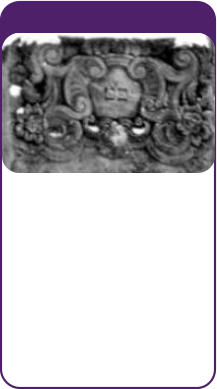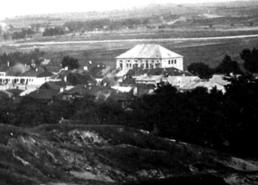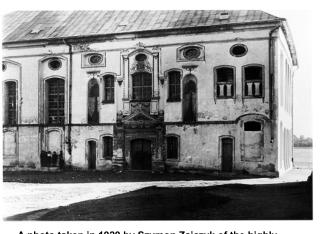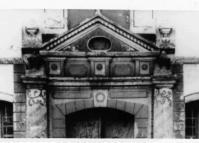


Działoszyn Matzeva
The elaborately carved, snow
covered lintel of an 18th
century
Działoszyn
matzeva
(memorial stone) taken from a
pre 1945 photo - courtesy of
http://bagnowka.com/. The
cemetery was effectively
destroyed during WWII. More
details can be found at the
International Jewish Cemetery
Project.

A Very Old Resident
A copy of the death certificate
of Sara Mayerow of
Działoszyn
who died at the stated age of 97
years in 1819. Her two sons -
who were certified witnesses -
were a master tailor and one of
the
town’s innkeepers.
Founding of the Jewish Community
The privately owned border town of Działoszyn was, for much of its
history, in the possession of the Mêciñski family. This family were
Calvinists who led the way locally in the establishment of the reformation.
By the early 1600’s the town had a small Jewish population. Działoszyn
was devastated during the period of the Swedish invasion (Swedish
Deluge) of 1665 to 1660. As part of the rebuilding strategy, the Mêciñski
family appear to have invited Jewish families, initially from Wieluń (which
was about 15 miles distant) to work under favourable conditions in the
rebuilding of the town. The Mêciñskis were in an ideal position to do this;
being both the owners of the town and also the hereditary Castellans of
Wieluń.
In the late 17th century, the burghers of Wieluń finally succeeded in
expelling their Jewish population, using a charter right of Non tolerandis
Judaeis. The Mêciñskis encouraged those Jews to settle in their town
and, in common with many other noble families of Kalisz province, there
was established a relationship of toleration of the practice of Jewish
beliefs in exchange for taxation and the development of the noble family’s
business interests.
A Refuge for Persecuted Jews
In the first half of the 18th century the Jewish community played an
increasing role in the reconstruction and development of trade in the
town. Stanislaw Mêciñski and his wife led the city through this exceptional
period of reconstruction and rebuilt the castle/manor house and the town
'in the French style'. Działoszyn consisted then of around 130 houses
including the manor house and a church, 2 mills, 2 inns and a synagogue
reputedly built and decorated by Yehuda Leib - with later decoration
ascribed to the 19th century Jewish artist David Friedlander.
The Jewish population grew rapidly and by the 2nd half the 18th century
constituted half the total population of the town. To quote from the local
website recalling the period, "Działoszyn became a famous capital of
tolerance where Jews who had been excluded from other towns and cities
found their refuge”1.
The Synagogue
In the article There Once Was a Shtetl Dzialoszyn Mary Rozen wrote,
"The greatest pride of the Jews in Działoszyn was the synagogue. They
would boast that this was one of the most beautiful synagogues in
Poland. It was a tradition that this synagogue was in the 18th century by
the same Jewish master architect who had erected the gorgeous
synagogue in Przedbórz and, it was assumed, also in Pinczów. The
khazan [cantor] of the synagogue, who was called "the Litvak," prayed
with a choir of choir boys. When a guest would come to the shtetl, he was
taken to see the synagogue. When the aron kodesh [ark containing the
Torah scrolls] was opened, birds with which it was adorned, gave out
musical notes. It was said that only two such synagogues were found in
Poland, built by a German master.
"When the hakhnoses kalah married off Binele the hunchback of
Działoszyn to Zelik the water carrier from Pajczeno - the shtetl was joyful.
The wedding took place in the house of the gabbai (synagogue trustee),
Moishe Zalman Rusak, and all of the Jews in the shtetl were in-laws. The
groom and the bride were led to the khupah (wedding canopy) in the
synagogue courtyard as in all of the weddings in the shtetl. Household
utensils for the couple tumbled from the wedding presents that all of the
Jews of the shtetl had given. "
"There were no fights between the Jews and Christians. Jews were only
cursed with the word, Zydze. At kol nidre [prayer recited at the start of the
Yom Kippur - Day of Atonement - evening service annulling all vows) on
Yom Kippur, the leading Christians, such as the rejent (notary public), the
sedzia (judge), the soltys (village head) and the scribe for the government
office came to the synagogue."2.

Polish Jews circa 1760
Sources
Dzialoszyn: The Encyclopaedia of Jewish Communities, Poland, (Pinkas Hakehillot Polin) Volume I, pages 88-89 -
published by Yad Vashem, Jerusalem. Translation by Alex P. Korn
1. http://www.dzialoszyn.com.pl/
2. Tshenstokhover Yidn The Jews of Czestochowa, ed. R. Mahler, NY: United Czestochower Relief Committee and
Ladies Auxiliary, 1947. (Y)., There Once Was a Shtetl [Town] Dzialoszyn by Mary Rozen Translation by Alex Korn
3. Goldberg, Wein, eds., “Ksiêga kahału w Działoszyn ,” part 2, pp. 63–66, 73.
4. From the foreword to The Wielon Memorial Book by M. Mendelovitch & Halina Birenbaum
5. Goldberg, Wein, eds., “Ksiêga kahału w Działoszyn ,” part 1, pp. 95.

A photo taken in 1929 by Szymon Zajczyk of the highly
decorated façade and portico of the 18th century Działoszyn
synagogue - courtesy of Beth Hatefutsoth, Israel
Photo of the Działoszyn synagogue seen from
Wiatrakowa Góra (the mill hill) circa 1935
The Działoszyn Kahal
Apparently because of the comparatively large size of Jewish population in Działoszyn, the town became the
administrative centre of the regions Jewish communities. Establishing a Kahal (council) of Elders which undertook
a range of legal duties and responsibilities including tax collection. The Kahal was also responsible for appointing
the rabbi and other synagogue officials. In its prime, in the 18th century, there were 104 settlements belonging to
the Działoszyn community and overseen by its Kahal; among them the five towns/cities of Krzepice, Pajeczno,
Praszka, Wieruszów and Wieluń.
Collecting and paying the extraordinary state taxes and rental fees to the noblemen were a huge burden for the
Jewish people and the gathering of them caused friction between the Kahal and the various communities which
were farmed for payments. The Kahal was forced to borrow money from the nobility and the Catholic priests. Over
the years, payment of interest put the community (kehillah) under increasing duress and there appears to have
been defaults and further loans taken, until the delay in payments brought about prosecution by the lenders.
The formal processes of the Kahal are recorded in detail and exist to this day. It is clear from the records that in
conducting the business of the community the members undertook the work with something of a social function
included. The settlements of accounts made by the Elders (parnasim) of the Działoszyn kahal, include expenses
on mead and vodka drunk at the meetings of elders or the kahal3.
Tensions
The rigorous application of licenses and taxation produced numerous frictions between the community and the
Kahal. A number of these are recorded in the Kahal book - which exists in Hebrew, Yiddish and in a Polish
translation. One recorded dispute was that between Itzik ben Elkhanan and the Działoszyn Kahal which occured in
the summer of 1788 when “the Jew lcek, son of Elchanan of Kempno, expressed himself offensively regarding the
dignitaries of the Działoszyn community, who had imposed excessive taxes on his mother-in-law of Osjaków. This
came to the notice of the dignitaries who immediately prohibited him from trading with Jews of their community.
Only after he had apologized, did they authorize the renewal of his trading with the Jews of that community.”4
Another example is the entry in the pinkas from 1789 that Kopel, one of the local citizens living in the village of
Praszka, was one of those who complained and rebelled against the kahal, for which he and his offspring were
deprived of their citizenship. Another resident of Praszka, Herz, who spoke about the kahal in an offensive and
disrespectful way, was deprived of the privilege of a permanent seat in the synagogue 5.
The Kahal’s influence gradually waned as state legislation took away most of the Jewish council powers in the late
1700’s. Nevertheless, the demands to repay outstanding loans and taxes continued to weigh heavily on the
community and consequently the Kahal seems to have been seen, even in the later years, as an oppressor rather
than a co-ordinator of ‘good works’.
Records
The earliest records of the Jewish local authority (Kahal) of Dzialoszyn date from the government census of 1765.
This census list each male living in both the town and in the surrounding settlements which composed the
component parts of the organised Jewish local authority. Alex Korn - of Canada - has translated the Dzialoszyn
town entries and these can be seen at here. The original census, in pdf format, can be seen here.











